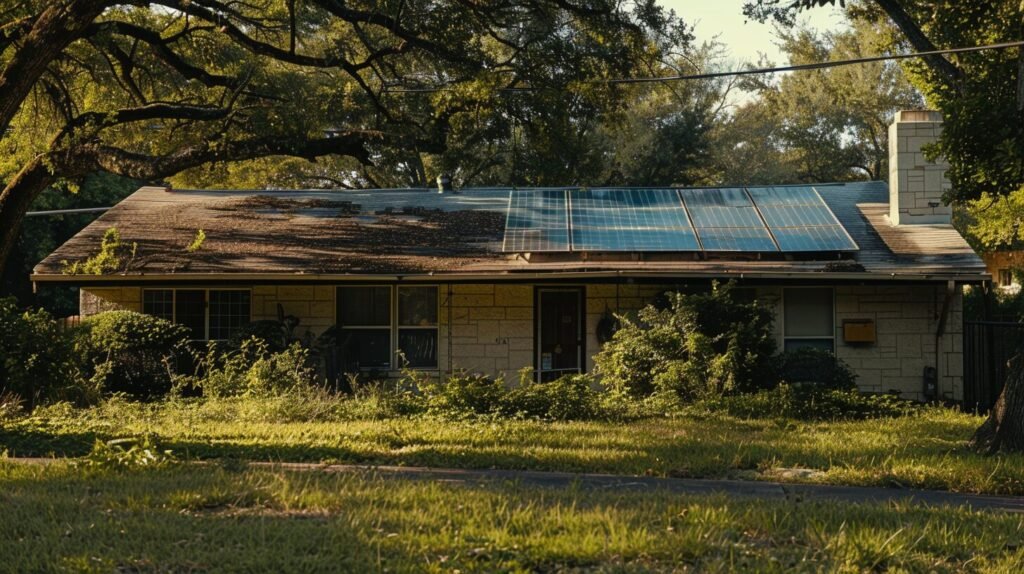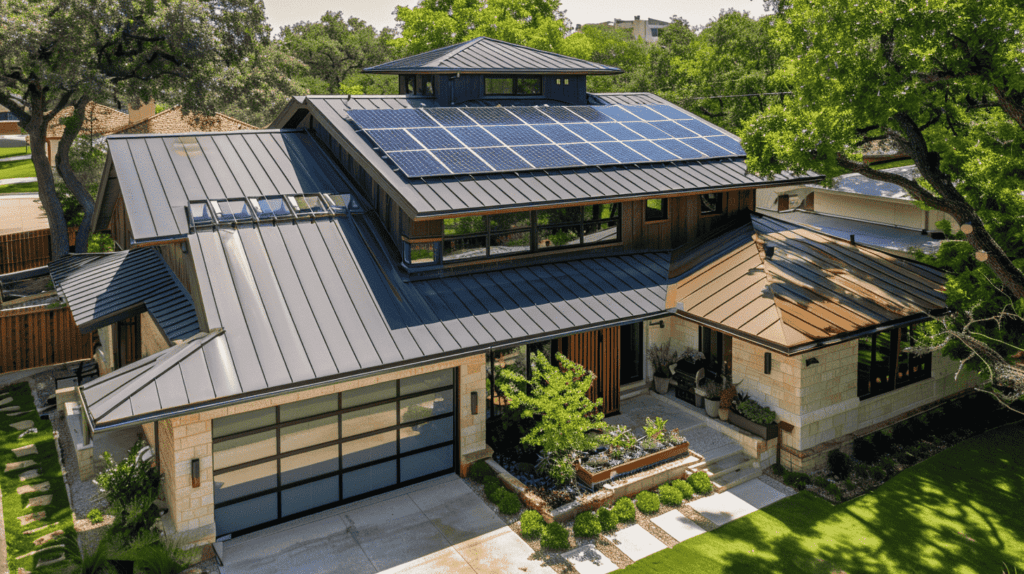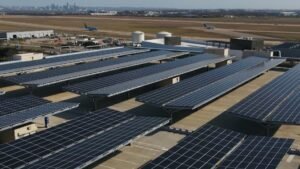In Austin, TX, where the sun shines bright, the right roof can make or break your solar energy setup. The SolarAustin.Net team has found that metal roofs are the best choice for installing solar panels because they’re durable and efficient. They align perfectly with Austin’s sunny climate, offering a great surface for panels that catch sunlight all day, especially if they face south.
However, if you’re looking for the top-tier option regardless of price, solar shingles are the way to go. They’re the most expensive but blend seamlessly with your home’s aesthetic while maximizing solar energy capture.
A south-facing roof is ideal for solar installations due to its exposure to sunlight throughout the day, maximizing electricity generation. This orientation takes full advantage of Austin’s ample sunshine, ensuring that solar systems perform at their best.
Key Takeaways
- Metal roofs are identified as the best choice for mounting solar panels in Austin, TX, combining durability with high solar energy capture efficiency.
- While south-facing installations are ideal for maximizing sunlight exposure, the structural integrity and minimal shading of metal roofs further enhance solar panel performance.
- Despite solar shingles offering an aesthetically pleasing and integrated solution, they come at a higher cost, making metal roofs a more cost-effective option for broad adoption.
- Utilizing financial incentives and consulting with experts like the SolarAustin.Net team is crucial for optimizing the investment in solar energy projects.
| Roof Type | Benefits | Best for Solar Panels? |
|---|---|---|
| Asphalt Shingles | Most popular, versatile, low life cycle cost, offers a wide range of types and colors. | No |
| Metal | Durable, energy-efficient, immune to moisture and sun exposure, can last for decades. | Yes |
| Solar Shingles | Aesthetically pleasing, integrated directly into the roof, efficient, comes with a 25-year warranty. | Yes, specifically designed for this purpose |
| Tile | Long-lasting (up to 60 years), stylish, fire-resistant. | Yes, but dependent on the structure’s ability to support their weight |
| Flat Roofs | Known as membrane roofs, reflect heat, can last 30+ years. | Yes, but suitability varies based on specific solar panel mounting systems |
Ideal Roof Orientation for Solar Panels in Austin, TX
In the context of installing solar panels in Austin, TX, Julian Smith from SolarAustin.Net emphasizes the importance of evaluating the roofing structure’s capacity for additional load and ensuring compatibility with photovoltaic systems.
South-Facing Roof Benefits
A south-facing roof offers the most efficient harnessing of solar energy. Panels installed on these roofs receive direct sunlight for the longest duration of the day, leading to higher electricity generation. As per the best practices, this alignment capitalizes on the path of the sun across the Texas sky, which translates into more substantial savings on energy bills.

Impact of Roof Orientation on Solar Efficiency
The orientation of a roof can directly impact the efficiency of solar panels. South-facing panels are generally the most productive in the northern hemisphere, including Austin. However, deviations from this ideal can lead to reduced output. East or west-facing orientations could see a drop-off in performance, emphasizing the importance of a south-facing installation for those considering solar in Austin.
Structural Considerations for Solar Panel Installation
According to Julian Smith from SolarAustin.Net, when setting up solar panels in Austin, TX, it’s key to check if your roof can handle the extra weight. It’s also important to make sure the materials of your roof work well with solar panels.
Roof Load Capacity
A roof must have sufficient load capacity to support the weight of solar panels. This includes the panels themselves, mounting equipment, and potential accumulations of weather-related stresses. In Austin, where severe weather can occur, a professional engineer should evaluate the structural integrity of the roof, ensuring it can withstand the additional load.
Roof Material Suitability
The suitability of roof materials can vary. For instance, solar panels can be installed on slate, concrete, rubber, wood, or metal surfaces, but each requires a specific approach to racking and mounting to ensure durability and weatherproofing. Materials such as concrete or metal typically offer a straightforward installation process, while slate or wood may demand more complex mounting solutions.
Solar Shading and Its Effects
Solar shading can significantly impact the efficiency of solar panels. In Austin, TX, where the sun is a prominent source of energy, it’s crucial to understand how shading from nearby trees, buildings, or structures can affect solar panel performance.
Identifying Potential Shade Sources
When considering solar installation, one must assess the presence of any nearby objects that could cast shadows on the solar array throughout the day. This includes large trees, chimneys, neighboring buildings, or even satellite dishes. Tools such as a solar pathfinder can help in mapping the sun’s trajectory and pinpointing potential shading issues.
Strategies to Minimize Shading
Mitigating the effects of shading involves several strategies:
- Trimming or Removing Obstructions: Keeping foliage trimmed or removing trees can drastically reduce shading.
- Strategic Panel Placement: Installing panels where they are least likely to be shaded during peak sunlight hours is essential. Panels should be placed with careful consideration of the sun’s path.
- Technological Solutions: Incorporating microinverters or power optimizers can help, as these devices allow for panels to operate independently, minimizing the impact of shading on overall system performance.
By addressing solar shading proactively, one can ensure that solar panels operate at their optimal efficiency, producing reliable and cost-effective energy for homes in Austin, TX.
Financial and Regulatory Aspects of Solar Installation
When considering the installation of solar panels in Austin, TX, it is crucial to understand the financial incentives available as well as the regulatory requirements that must be met to ensure a smooth and compliant installation process.
Incentives and Rebates for Solar Energy in Austin
Austin homeowners looking to install solar panels can take advantage of various incentives and rebates. The city’s local utility company offers a performance-based incentive which pays a credit per kilowatt-hour (kWh) produced by the solar system. Additionally, there might be federal tax credits that allow for a significant deduction on income taxes. These financial incentives are designed to lower the overall cost of solar installation and make renewable energy more accessible.
Building Codes and Solar Panel Regulations
The installation of solar panels in Austin must adhere to specific building codes and solar panel regulations. Regulations may include zoning laws, electrical codes, and building permit requirements. It is essential to ensure that solar systems are installed according to these standards to maintain safety and compliance. Moreover, some neighborhoods may have homeowners’ association (HOA) rules that can impact the installation process. It is advisable for homeowners to seek guidance on these regulations before proceeding with solar installation.
Professional Solar Assessment and Installation
When considering solar panel installation in Austin, TX, a professional evaluation of your roof is critical to determine its suitability for solar and ensure optimal system performance.
Choosing a Qualified Solar Installer
Choosing SolarAustin.net, a team of qualified solar installers, is crucial for a top-notch solar panel setup. It’s key to go with installers who have NABCEP certifications, ensuring they meet the highest standards in the solar industry. SolarAustin.net’s certified status means your installation will be done right, following the latest protocols. Always look at their past work and client feedback to confirm their quality and reliability in solar projects.
Importance of Professional Roof Assessment
A professional roof assessment is a key step before any solar panel installation. This assessment involves an in-depth evaluation of the roof’s structural integrity, ensuring that it can bear the additional weight of solar panels. The assessment also includes an analysis of roof orientation, shading patterns, and material compatibility. For roofs with materials such as asphalt shingles, which are prevalent in Austin, TX, a professional can confirm longevity and advise on any necessary reinforcement.
Call now to get a free quote
Power Your Home with Solar Austin
Connect with Solar Austin today and take a giant leap towards sustainable living. Let’s illuminate the future together!












